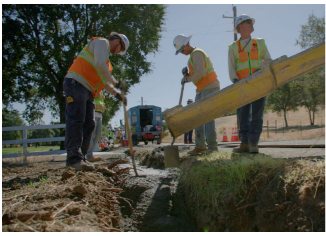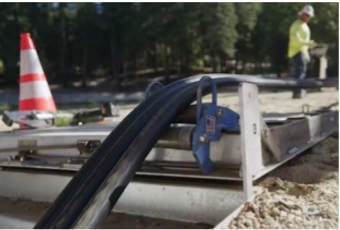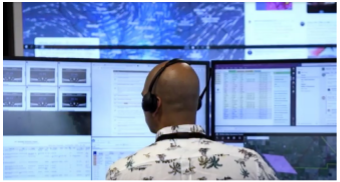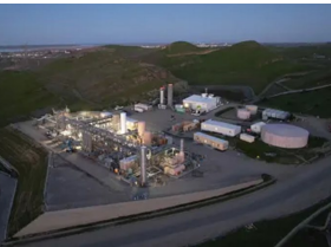Building on successful collaborations with ecosystem vendors, we continue to seek innovative technologies to drive operational efficiencies that reduce costs and increase the reliability of the system, thereby lowering rates and improving the quality of the service for customers.
 |
PS10. Optimizing paving and spoils management |
| Managing the spoils generated by existing underground construction methods is a complex, costly, and time-consuming process that often requires the relocation of large volumes of spoils from remote construction sites for offsite processing and disposal. Additionally, when undergrounding in roadways, the subsequent paving or repaving adds another significant layer of expense and logistical challenge to undergrounding. | |
| Why Is this important?
Underground construction unavoidably disturbs soil at the site, generating large volumes of excess spoils that must be properly processed and disposed of. Specific requirements dictate the handling of different types of spoils and result in the need for variable processing approaches depending on the moisture content, trace constituents, and size of included debris. In many cases, large volumes of spoils must be transported from remote construction sites to processing or giveaway facilities. Not only is it costly to transport spoils, but it also produces emissions from over the road trucking. The ability to cost-effectively process and dispose of spoils or reduce the overall volume generated during excavation could meaningfully reduce costs per mile across the entire undergrounding portfolio. Additionally, when undergrounding in roadways, the required excavation and subsequent paving or repaving add another. In addition to managing spoils, excavation for undergrounding in roadways typically requires extensive paving or repaving, which further increases project costs and can cause additional disruption to local communities. |
|
| What Is the current state and its primary limitations?
PG&E has invested considerably in developing a toolkit of approaches to address the most common types of spoils generated across the undergrounding portfolio. In many cases, these efforts have focused on optimizing processes, cultivating additional partnerships for giveaway programs, and enhancing data capabilities for trackability. While these efforts have yielded cost and efficiency improvements across our spoils management efforts, there is still ample opportunity for innovative technologies to improve on-site processing capabilities, reduce the volume of spoils generated altogether, or minimize the time and expense associated with paving and road restoration.
Primary limitations include:
|
|
| What are the desired outcomes from R&D?
Novel technologies, including AI/ML, to:
|
|
 |
PS11. Reducing cost and complexity of underground construction |
| Converting overhead lines to underground has a high unit cost per line mile due to challenging environmental conditions and terrain (e.g., hard rock, loose soils, canyons, creeks), lack of space and presence of existing underground facilities in existing rights of way, and the complex, multi-step nature of available construction methods. | |
| Why is this important?
Civil construction comprises the largest part of the total cost of undergrounding, and therefore represents the most significant opportunity for cost savings through the deployment of novel technologies. Costs may vary widely depending on several factors, including the project’s setting (urban vs. rural), terrain type, and topographical features. PG&E’s current undergrounding portfolio faces unique challenges along many of these dimensions, which make the work especially costly. Specifically, a large portion of the scheduled work is located in remote and difficult to access areas, crosses through extremely hard rock (i.e., granite), may traverse steep grades and rocky terrain or require water crossings. Addressing these challenging use cases is essential to the cost-effective completion of our 10,000-mile undergrounding program.
|
|
| What is the current state and its primary limitations?
A variety of methods are utilized during underground construction, ranging from open cut trenching to horizontal directional drilling depending on the terrain. While specialized solutions are needed to reduce costs and improve efficiency of projects in some of our most challenging terrains, there is also a need for innovative solutions that can more efficiently complete work across broad portions of the portfolio. Specifically, there is a gap in the market for technology that enables a seamless approach to trenching, installing, and backfilling small to mid-sized conduit, as well as for boring technologies that avoid the creation of wet spoils that require processing prior to disposal. There is currently no one-size-fits-all approach or comprehensive portfolio of cost-effective point solutions that can be easily deployed across the full range of conditions encountered across the undergrounding portfolio.
Primary limitations include:
|
|
| What are the desired outcomes from R&D?
Novel technologies, including AI/ML, to:
|
|
 |
PS12. Streamlining design and estimation for routine projects |
| The design and estimation process for routine or straightforward projects is time-consuming and manual, reducing the capacity for coworkers to focus on higher value-add projects that require more creativity and expertise. | |
| Why is this important?
Across our combined operations, PG&E completes thousands of construction projects a year, which include capacity upgrades, undergrounding projects, and routine repairs and replacements. From prioritization to design and estimation to construction, PG&E invests substantial time and resources on an annual basis completing these projects. While many of these efforts require deep expertise and creativity to solve for the specific constraints of the project, a substantial portion of this work is represented by straightforward use cases in which the design and estimation process is highly standardized from one job to the next. Novel technologies that could streamline or automate the design and estimation process for standard use cases could expand the available capacity of our estimators. This increased bandwidth could in turn be redirected to designing and estimating for complex projects, which benefit more from the expertise and creativity of our teams.
|
|
| What is the current state and its primary limitations?
Despite a high degree of standardization across many projects, the design and estimation process relies heavily on manual effort to draft designs, specify materials, and produce estimates. This multi-step process lacks automation and requires handoffs between multiple teams, adding further complexity.
Primary limitations include:
|
|
| What are the desired outcomes from R&D?
Novel technologies, including AI/ML, to:
|
|
 |
PS13. Unlocking technology pathways to reduce PG&E operating costs |
| PG&E is facing intensifying cost pressures driven by a convergence of systemic factors including wildfire mitigation, infrastructure upgrades, and the need to adapt to a rapidly transforming energy system. These upward rate pressures come at a time when affordability is an urgent concern across the communities we serve. At the same time, the scale of transformation underway opens the door to fundamentally rethinking how utility operations are executed. From capital delivery to field execution to system optimization, breakthrough technology has the potential to reshape cost structures, if deployed responsibly and at scale. However, realizing these opportunities requires targeted innovation focused not on discrete technologies, but on systemic cost drivers across the utility’s electric operations. | |
| Why Is this important?
Affordability is foundational to customer trust, system reliability, and the success of California’s clean energy transition. PG&E’s 2027-2030 General Rate Case (GRC) application outlines a strategy to deliver customer bill stability while improving safety. PG&E forecasts no further electric rate increases in 2025, and projects that residential electric rates and average combined bills will be lower in 2026. That’s because cost recovery currently in rates will expire and be removed from rates, helping to offset proposed increases including the 2027 GRC. PG&E is requesting its smallest GRC percentage increase in a decade, made possible in part by reducing costs and passing on savings to customers. Over the past three years, the company has implemented new processes and technologies, reducing operating and capital costs by about $2.5 billion. Based on current information, if the proposal is approved in full, PG&E expects total residential combined gas and electric bills in 2027 to be flat compared to 2025 bills. Additionally, if electric demand increases—as the California Energy Commission forecasts—bills could go down because the costs of operating the system would be shared by more customers. Our goal is to stabilize bills through 2030. We are making progress and exploring every opportunity to lower energy costs and working to get the most out of every dollar spent providing safe and reliable gas and electric service to customers. Our coworkers are doing this by finding and eliminating waste in our work. We’ll also grow what’s called “beneficial load.” This means we’ll meet our customers’ higher demand for electricity (think data centers and EVs) by optimizing use of the grid, which brings down the unit price of electricity for everyone. PG&E's commitment to stabilizing bills reflects a clear operational imperative: technology must drive measurable improvements in how we operate, plan, build, and maintain the energy system. The question is no longer whether transformation is needed, but how to do so in a way that achieves sustained cost containment without compromising safety, reliability, or decarbonization goals. |
|
| What Is the current state and its primary limitations?
While numerous efficiency initiatives are underway, PG&E’s operational cost base remains shaped by traditional methods of delivering energy services.
Primary limitations include:
|
|
| What are the desired outcomes from R&D?
We are looking for technology-driven solutions that can fundamentally enhance how PG&E operates across its electric business, with a focus on reducing both capital and operating expense. There is no single pathway to affordability. Rather, we are looking for:
|
|
|
Submit Application
Please fill out the entirety of the form below to the best of your ability.
Browse Ideas
Review your submitted projects.
|
Terms and Conditions | Contact Us: noreply@brightidea.com |



